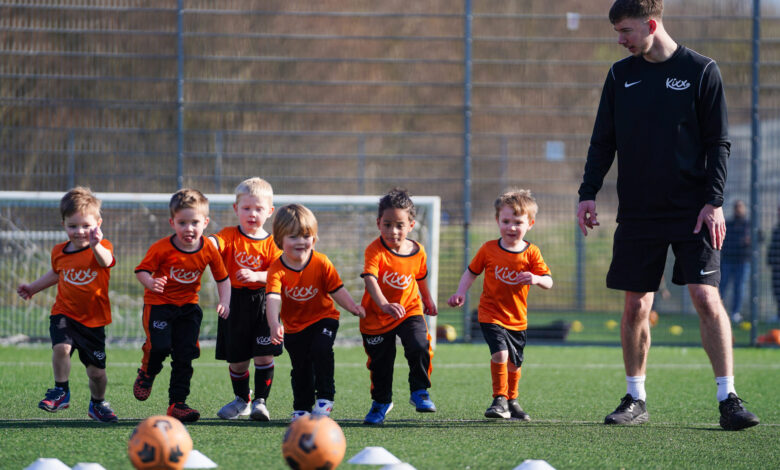A Parent’s Guide to Choosing Toddler Football Classes

Enrolling your toddler in a football class goes beyond picking a nearby program—it’s an opportunity to encourage physical development, nurture social interaction, and inspire a lasting enthusiasm for staying active. With numerous options out there, how do you determine which one is the best fit? Toddlers have unique developmental needs, and not every football class is suited for them. From the coaching style to class structure, every detail can impact your child’s experience. This guide will help you find the most suitable football class for your toddler.
1. Consider Your Toddler’s Age and Developmental Stage
Football classes for toddlers are usually broken into specific age groups—such as 2–3 years, and 3–5 years. These divisions matter because the physical and emotional capabilities of toddlers vary significantly even within a few months. For example, football classes for 2 year olds should focus on gentle, guided play that encourages basic coordination and movement in a supportive environment. Make sure the class is tailored to your child’s current stage. Programs that respect these differences will include activities focused on simple motor skills, balance, basic movement coordination, and playful interaction instead of structured games or competitive play.
2. Prioritize Play-Based Learning
Toddlers learn best through play. That’s why the best football classes at this age aren’t focused on rules or goals but rather on fun, imaginative activities that involve kicking, chasing, and following instructions. Look for a class that emphasizes creativity—like pretending cones are mountains or balls are treasure. Programs that use themes or stories to guide activities can keep toddlers engaged and support their cognitive development alongside physical growth.
3. Check the Coach’s Experience with Toddlers
A good coach isn’t just skilled in football—they must also understand early childhood development. Ask about their qualifications, especially in working with young children. Do they speak gently and patiently? Are they able to redirect a distracted toddler with ease? Can they adapt the activity if a child is struggling or shy? Coaches who are positive, encouraging, and enthusiastic will help your toddler feel confident and safe, which is critical at this stage.
4. Look at the Class Size and Child-to-Coach Ratio
Smaller groups mean more personalized attention, which is crucial for toddlers who may need extra help or reassurance during class. Preferably, the ratio of children to coaches should be small—about five kids per coach or fewer. This allows coaches to guide each child individually and ensures a safer, more controlled environment. Large, overcrowded classes may be overwhelming and reduce the effectiveness of learning through play.
5. Evaluate the Environment
The physical space of the football class should be safe, clean, and age-appropriate. For toddlers, that means soft surfaces, enclosed spaces, and equipment designed for smaller hands and feet. Whether it’s held indoors or outside, the area should be free of distractions, with enough room for children to move comfortably without bumping into each other. If possible, visit the location before signing up to observe how the space is used during a session.
6. Observe the Structure of the Class
Even toddlers benefit from a basic routine. A well-designed football class will typically follow a consistent pattern: a fun warm-up, skill-building activities, interactive games, and a calming cooldown. Structure helps toddlers understand what to expect and feel secure in the environment. However, the activities within that structure should be flexible enough to accommodate a toddler’s short attention span and varying energy levels.
7. Ensure a Positive, Non-Competitive Atmosphere
At this age, the focus should be on participation and enjoyment—not winning or comparing performance. It’s important for toddlers to feel secure when exploring new activities and learning from their mistakes. A supportive environment allows children to discover movement freely, without feeling any pressure. Coaches should celebrate effort and improvement rather than outcomes, helping children build self-esteem and emotional resilience.
8. Consider Parental Involvement
Some toddler football classes involve parents directly, especially for younger age groups. In certain programs, parents are encouraged to watch the session from the sidelines. Think about which approach aligns best with your child’s temperament and requirements. If your toddler is shy or new to group activities, a class that includes parent participation might make them feel more secure. On the other hand, more independent children might enjoy the chance to explore on their own with gentle guidance from a coach.
9. Read Reviews and Ask Other Parents
Recommendations from other parents are among the most reliable ways to discover quality programs for toddlers. Ask other parents in your area about their experiences with local football classes. Read reviews online, but be sure to look for specific mentions of how the class supports toddler development, how well the coaches interact with children, and whether the atmosphere is friendly and welcoming. Trust your instincts—if other parents say the class feels too structured or chaotic, it’s probably not the right fit.
10. Give It a Trial Run
Many football programs offer trial sessions or short-term sign-ups. Take advantage of these before committing to a full term. Watch how your toddler reacts. Are they engaged, smiling, and eager to participate? Or do they seem confused or overwhelmed? Some hesitation at first is normal, but a well-run class should ease those feelings within a few sessions. If your child isn’t enjoying it, it may just be the wrong class—or the wrong time.
Conclusion
Finding the right football class for your toddler doesn’t have to be a stressful task. By focusing on your child’s needs, personality, and stage of development, you can choose a program that supports their growth while keeping the experience fun and rewarding. The right class will not only teach them how to kick a ball but also help them build confidence, make new friends, and discover the joy of movement. It’s not about raising a football star—it’s about giving your little one a great start.





